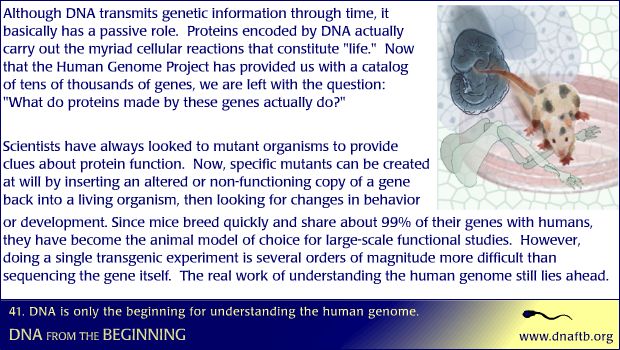Concept 41: DNA is only the beginning for understanding the human genome.

Discovering protein function is the next step in understanding the human genome.
Although DNA transmits genetic information through time, it basically has a passive role. Proteins encoded by DNA actually carry out the myriad cellular reactions that constitute "life." Now that the Human Genome Project has provided us with a catalog of tens of thousands of genes, we are left with the question: "What do proteins made by these genes actually do?" Scientists have always looked to mutant organisms to provide clues about protein function. Now, specific mutants can be created at will by inserting an altered or non-functioning copy of a gene back into a living organism, then looking for changes in behavior or development. Since mice breed quickly and share about 99% of their genes with humans, they have become the animal model of choice for large-scale functional studies. However, doing a single transgenic experiment is several orders of magnitude more difficult than sequencing the gene itself. The real work of understanding the human genome still lies ahead.
human genome project, protein function, living organism, cellular reactions, passive role, orders of magnitude, functional studies, genetic information, mutants, transgenic, genes, proteins, dna
- ID: 16855
- Source: DNALC.DNAFTB
Related Content
548. Model Center
Model organisms share with humans many key biochemical and physiological functions that have been conserved (maintained) by evolution.
16491. Biography 21: Sydney Brenner (1927-2019)
Sydney Brenner showed that mRNA was the unstable intermediate that carried the message from DNA to the ribosomes.
16834. Animation 40: Living things share common genes.
Mike Wigler shows how all organisms share similar genes, called homologs.
16856. Animation 41: DNA is only the beginning for understanding the human genome.
Mario Capecchi describes proteomics; the large-scale study of protein structure and function. Brian Sauer explains gene knock outs.
1363. Genes for memory (lesson)
Students will experiment with an interactive animation to compare mutant and wild-type mice in a water maze. They will analyze data and discuss findings of a research paper.
16987. Evolution of Complexity - Single Cells to Complex Brains
Dr. Nicole King and Dr. Seth Grant join Cold Spring Harbor Laboratory's David Micklos to discuss the evolution of complex, multicellular animals. Remarkably, the molecules that have driven brain evolution, are the same molecules found in simple unicellula
16784. Animation 38: Development balances cell growth and death.
Leland Hartwell describes how cells regulate the timing of growth and cell division. Bob Horvitz and Mike Hengartner explain control mechanisms for cell death.
16833. Concept 40: Living things share common genes.
All organisms store genetic information in DNA and RNA.
16854. Problem 40: Living things share common genes.
Find a cystic fibrosis protein function using bioinformatics to study homologs in model organisms.
1361. Model Organisms (Lesson)
Students work through a series of experiments that investigate the use of model organisms in the search for a better understanding of the genes that influence memory formation.












